|
Main
The Fleet
|
Completed RocketsWyvern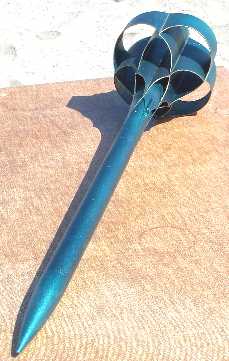
I really like this design, and am very happy with how it flies. B6-4's give it a nice low flight, but a bit of a late eject. B6-2's fly much better, ejection JUST prior to apogee. C6-5's work well, while C6-3's eject too early. I wouldn't recommend any other engines, due to its heavy weight. I had to put .6 ounces of lead in the nose to make it stable, bringing the total weight to 3.6oz. Included on this page are templates and instructions for making your own Wyvern. I've revised the template images to make them smaller. They should be printable on a single page now, but you'll have to assemble the complete Fin Shape Template from the two halves.
I've never seen any other rocket that uses interlocking tube fins like this one. If you know of one, please drop me an email and tell me about it. I'd love to see what others have done with this technique.
Infinite Loop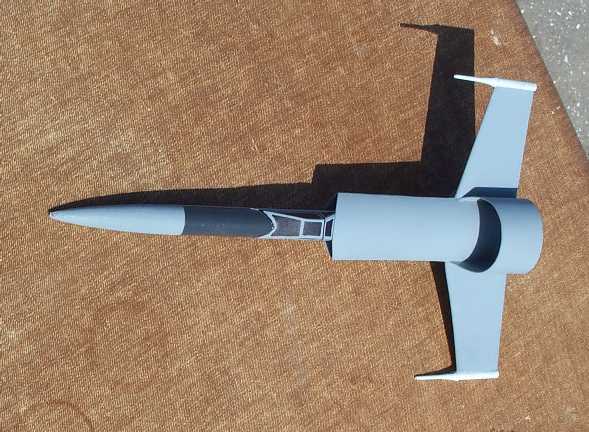
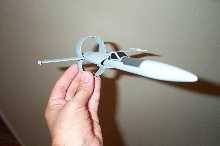 More images in the Gallery The Infinite Loop is a Starfighter design using a similar interlocking tube fin technique as that used on the Wyvern. The body tube, engine mount and nose cone are all MPC parts, picked up in an auction on eBay. The rocket features rear ejection. The MPC body tube is a bit larger than Estes BT-5. The engine mount tube is very close to BT-5 size, and fits smoothly into the rear of the body tube. A small slice of body tube was cut off and glued to the rear end of the engine mount tube, providing a thrust ring that support the rocket under boost. The engine mount tube has an engine block forward, for the engine to push against. Finally, a safety pin was trimmed to form a spring-loaded U shape, and inserted into the front end of the engine mount. This safety pin was tied to the shock chord (kevlar), which was also tied to an eye hook screw up in the nose cone. On ejection, the whole engine mount tube is supposed to eject, draggin the streamer on the shock chord out of the body tube to the rear. Unfortunately, the cellulose wadding I used jammed in the tube, preventing the streamer from deploying. The resulting lawn dart landing scuffed the nose, but did no other damage. Thank goodness for the sand on the island where we launch. The upper and lower ring fins (you can't see the lower one in the pic), and the scoops are all formed from two pieces of BT-60 that are cut to interlock. The cockpit is made from thin cardstock. The rocket flew very nicely on a 1/2A3-4T. The eject was just about at apogee. Maybe a little late. I plan to rebuild this design using standard Estes parts (BT-5), and nose ejection. When I get that done I'll post templates for the various pieces, including the tube fins, wings, and cockpit.
Downscaled Estes Condor
Capsule Lander from Spare Parts
Estes Astron InvaderThe Astron Invader is a very old boost glider design. I built this one from plans on Jim Z's site. Construction was pretty straightforward. The article available with the plans helped a bit. The only glitch in construction was getting the angles sanded into bases of the pylons so that the engine pod was securely attached to the circular "wing." If I have to build another of these (and, hey, it's a boost glider), I'll figure out some way to support the wing after the dihedral has been added so that I can tape sand paper directly to the upper surface and use it as a jig when sanding the matching angle into the assembled engine pod.I haven't flown this one just yet. After successfully trimming it at home in the back yard, I took it out to the launch site and gave it a quick toss test. Immediate nose dive. I tried again, and once again it dug into the dirt. I can only think that my soft tosses in the back yard didn't show the true trim of the glider. I'll re-trim and toss test it at a nearby park before putting an engine in it. Well, I don't get it. I've tried trimming this bird every way I can. No matter where I put the clay, or how much I put on, I can't get it to fly straight. I suspect I used balsa that is too heavy. I think it's too thick...the balsa I had in the proper thickness wasn't contest grade, so I used the next size up. New note: I think this bird will never fly now. I took it to my daughter's pre-school, and attempted to show the kids how it was supposed to glide, giving it a nice soft toss. The bird took an immediate nose dive right into a tiny strip of concrete, surrounded on all sides by nice soft sponge rubber play surface. The engine tube and pylons snapped right off the main body plate....time to consider building another one with the right material, I think.
Quest Falcon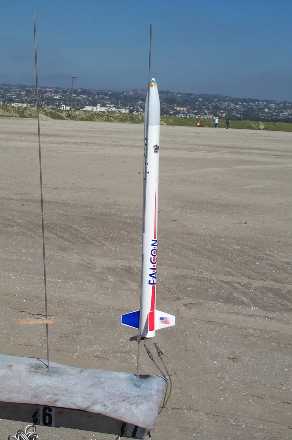
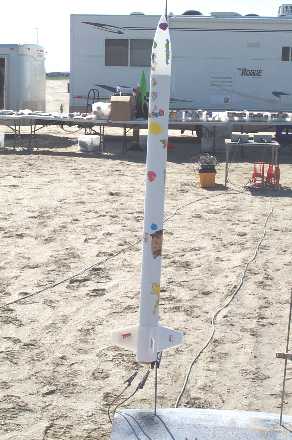
My daughter picked this one out at our first club launch. This one is a much better choice than her first kit (an Estes Yankee) for building with a small child. The engine mount is assembled with plastic model cement, and the fin section is a one piece, cast plastic affair. The latter feature meant that, as soon as the bag was opened, she could stick the nose cone on one end of the body tube, the fin unit on the other, and zoom it around the room. She loved that. Any time you can involve the imagination of your young budding astronaut, it's a good thing. Now I thought that this model would avoid the painting issue entirely, as it comes in all white and the decal stickers can go straight onto the model. But (at first) she wanted it to be pink... Eventually (when we got close to finishing it) she changed her mind, deciding that her "new favorite color was white" so that she could start putting stickers on immediately. We put the kit stickers (another good feature for rocket building with little ones) on, then "made it pretty" by adding hearts, kitties and flowers from her sticker collection. We had a blast building this rocket together, and can't wait to fly it next weekend. Another good decoration option is to take some of her own computer (or other) artwork and laminate it onto the body tube using contact cement. She seemed pretty excited about that possibility. Maybe next time. Over all, the model went together easily, and she could help with most of the steps. She paid very close attention to how I tied the shroud lines to the chute, and tried it once or twice herself. She couldn't do it yet, but she tried and she had fun. She did manage to cut the chute out by herself, and got a big thrill out of that. I'd highly recommend this kit if you want to teach a small child about the basics of building. I'll be looking for similar features in our next rocket.
Estes Bullpup 12D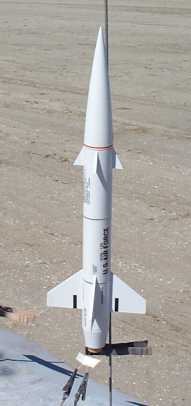 Anyway, the rocket is ready for flight this weekend. I'll post a flight log with details soon. 2/5/2003: Last night I put three coats of white gloss paint on the rocket. It's cold in the garage, but by keeping the paint cans inside and warm (I sat on them while watching TV between coats) I was able to maintain a nice smooth surface on the rocket. Spray paint that is too cold when applied tends to create a pebbled surface. 2/4/2003: I finished filling and sanding all of the fins last night. A sanding block helps a lot when you want to keep fins straight and flat. I've finished all of the assembly now. Thursday night is painting night for this model, and for the Gyroc and Mini-Shuttle. With luck I'll have three new rockets ready for this weekend's launch. 1/27/2003: while working on filling the wings and tail for the Mini-Shuttle, I applied a coat of filler to the fins of the Bullpup as well. Just some sanding to do before this bird is ready for paint. 1/20/2003: More fillets last night. I grew bored waiting for them to dry, and so I started yet another rocket...see the Estes Mini-Shuttle below. I think I'll investigate the use of epoxy putty for fillets. It's certainly stronger, and you can apply all of them at once. The putty doesn't droop with gravity, so you don't have to wait for one side to dry before working on the next. I'll fill and sand the fins on the Bullpup, complete the Mini-Shuttle, and break out the gloss white paint for them both next week. The Gyroc will get a paint job the same night. 1/16/2003: The fins went on easily, but I would really love to have one of the old Estes Fin Alignment Guides. I just don't trust myself to eyeball truly straight fins. Anyway, the fins are on and the first fillets have been applied to one pair. More fillets to come, followed by sealing and sanding. Should be ready for paint in another hobby night or two. 1/15/2003: I'm a little surprised that this model is considered a skill level 2 kit. There is only one step that is more complicated than a typical skill level 1 kit: using a razor saw to cut parts of the plastic transition off to create the model's boat tail. In about an hour and a half I had the engine mount and boat tail assembled, and had all the fins sanded and ready for gluing. Two or three more night's work ought to have this model ready for paint. It sure is a nice looking rocket.
Estes Gyroc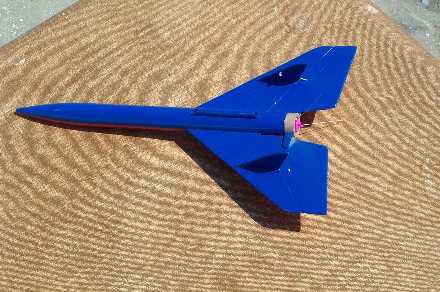
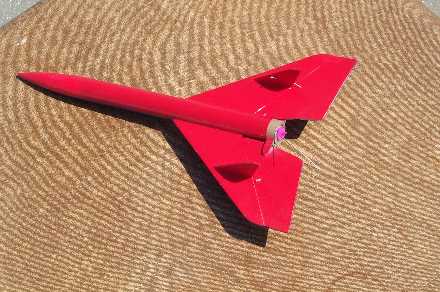
2/8/2003: Rigging up the elastic string that serve as actuators for the flaps proved to be pretty straightforward. I chose to use CA to fix the string in place instead of white glue, as I couldn't see holding the elastic at tension long enough for white glue to set. The CA did wick up the string a short distance, but not enough to reduce the power of the elastic. A couple of dry tests showed that the flaps spring into position quite nicely when the engine is pulled out of the rocket. A toss test in the back yard showed that it spins nicely, reliably turning itself into a lawn dart. I'm looking forward to flying this one. 2/5/2003: I put the blue coat on last night, finishing the paint job. I'd run out of masking tap, and used Scotch tape instead. It worked, but it's less flexible than masking tape. This meant that the masking at inside corners (e.g. where the fins meet the body tube) pulled up a tiny bit, allowing some bleed through. 2/4/2003: I plan to paint this rocket red on one side, and blue on the other. Tonight I put on a good coat of red paint on one side, letting the overspray fall where it will. I should really have started with a white undercoat. The color difference between the body tube (brown paper) and the nose cone (white plastic) is noticeable. I may try to put more red on to reduce the problem. 1/15/2003: I finished sanding out the filler coat last night. I'd planned to go straight to painting, but it's cold at night here and spray painting needs to be done in the garage with the door open. In order to get good coverage with the paint I need to keep the cans warm inside, taking them into the garage to put on a new coat each time. In short, this is a step best done on several models at once. So, I started building by Estes Bullpup instead. See below. 1/13/2003: Construction is going well. I'm about to finish sanding the coat of Elmer's Wood Filler that I use instead of sanding sealer. Then it's down to painting and adding the elastic "actuators." The only tricky bit is going to be giving the model a spin test to establish flight stability. I used an ogive plastic nose cone instead of the balsa code called for in the plans, and I may well need to add some clay in the nose to make it stable. With the wide fins, I probably have nothing to worry about, but I want to be safe. Those same wide fins make it difficult to attach a string to the model for swing testing without damaging the leading edges. I hope to fly this for the first time at next month's club meeting. Check the flight logs for the results.
Estes Mini-Shuttle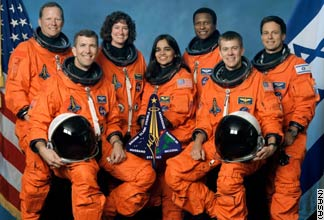
8/31/2003: After a long, full summer with no hobby time, Sarah and I finally flew rockets again today. The Mini-Shuttle went up on its maiden flight of a B6-4 for a beautiful, straight boost. Ejection was a little late. A B6-2 may be a better choice. I'll try it next time, but it was nice to see this rocket fly. The original used a balsa nose cone. The shoulder of that cone was shorter then the equivalent PNC shoulder. In order to leave room for the streamer, I had to chop away a lot of the angled part of the shoulder, leaving only the tab on which the shock chord mount is cast. The streamer (1.5" x 15" mylar safety blanket material) easily fits up into the nose and deployed flawlessly. 2/9/2003: Well, winter finally came to Southern California, and the flu season came with it. Sarah and I didn't get to fly our rockets this weekend, spending the time in bed instead. Oh well. I did manage to get the rest of the painting done on the Mini-Shuttle. The black gloss coat went on easily enough, but I grew impatient and peeled off the masking before the paint was really fully dry. The result: a big ugly black thumprint on the white upper surface of the shuttle. Thankfully, I'd planned to sand this area down anyway, to allow for the application of the "decals." My decals are simply printed onto normal paper, using the scanned decal images from Jim Z's site. I apply them by sanding the paint where the decal will go, smearing white glue onto the model, then carefully laying the printed paper onto the model. It worked quite nicely. They don't lay nearly as flush as real decals would, but I don't have the capacity to print decals myself and can't afford repro decals just yet. All that remains is the application of a couple of coats of clear gloss. I'm a bit worried about the way the printer ink will react to the overcoat. I'll try it on a spare printout first. 2/5/2003: The white paint coat went on with no problems. I was surprised how obvious the spiral lines in the body tube were after paint. Clearly, some work filling these lines in on my next models will pay off in appearance. The fins, too, could have used another coat of filler. They looked and felt so smooth after one coat, but the imperfections in the surface are clearly evident under the gloss paint. Two more nights of painting ought to do it for this rocket. Plus one more for the decal work. I'll fly it as is this weekend, though. I'm looking forward to it. 2/4/2003: Last night the final fillets went onto the model. All that remains of the assembly is to buy some shock cord and something to use for a streamer and tie everything together. Thursday night the white coat of paint will go on. Friday the black. It won't be totally finished for Saturday's launch, but it'll be flight ready. I'm looking forward to seeing this bird soar. 2/3/2003: I spent a lot of time last night sanding and filling the fins. After the loss of Columbia, I suddenly want this little shuttle to be as good as I can make it. The finished fins are now attached and the first fillets are done. One more night of filleting and final assembly and she'll be ready for paint. I'd planned to put a list of the astronaught's names on the bottom of the shuttle, but there really isn't enough room there. The launch lug is right in the middle of the shuttle's underbelly, and I don't trust my modeling instincts enough yet to relocate the lug. So, I'll put the memorial list on the back of the shuttle. It's more visible there anyway. One construction tip: I'm building this model and the Estes Bullpup at the same time. For this model, I built, filled and sanded the fins before attaching them to the model. For the Bullpup, I attached the fins, filleted, then filled and sanded. I very much prefer finishing the fins before they are attached. Being able to lay the fins flat on the worktable during sanding yields a better surface. Sanding the fins in place stresses the wood, too, as there is nothing behind the fins except the uncertain stability of my fingers during sanding.
2/1/2003: This morning, the Space Shuttle Columbia disintegrated during re-entry. I am stunned, and deeply saddenend by the loss of the seven astronaught that made up her crew. This mini-shuttle isn't the most fitting memorial, perhaps...a real Estes Space Shuttle would be nicer and I may find one to build for this purpose...but it will do for now. I'm going to create a paper "plaque" on my color printer, featuring the names and national flags of the seven heroes who died today, and apply it to the underside of my model before I put on the final gloss clear coat. Photos soon.
1/20/2003: Unable to control my building frenzy, I started this model while waiting for fillets to dry on my Bullpup (see above). I'm building this one from plans available on Jim Z's invaluable web site. The decals for this rocket are hugely important. Without them it's really just a BT-60 short rocket with odd fins. I don't have the facilities to make my own decals, so I'm going to try printing the decal image from Jim's site on paper and laminating the paper onto the rocket with glue. A coat of gloss varnish ought to seal them onto the rocket well enough, I think. Be very careful when laying out the fin patterns for this one. Because the "wings" are composed of three different pieces, you need to be very careful about keeping the dimensions at the joints correct. Especially where the thin triangles at the front and the main wing sections join. My advice would be to mark the fin stock carefully, cut past the desired edge, then sand to the marked line. Go gently and work up to a nice fit. Next steps will be attaching the fins and building the engine mount. Should take one more night for the basic construction, and two or three nights after that for filling and sanding.
On the WorkbenchEstes Yankee
Orca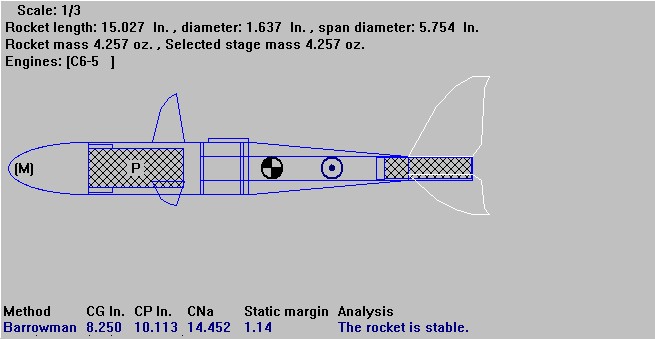
This rocket was inspired by my daughter's love of Killer Whales. The idea is to build a rocket that looks as much like an Orca as possible, while preserving flight stability (of course). The rocket will be made of commercially available parts, with two exceptions. The tail fins will be made of clear Lexan, and the transition shroud from main body tube to the engine mount tube will be made from heavy paper. The top rear fin will be left clear. Orca's have no corresponding tail fin, but this is needed for stability. The rest of the rocket will be given a classic black and white Killer Whale pattern. The rocket will recover using a normal ejection of the nose and attached parachute. I thought about using rear ejection to preserve the tail flukes (excuse me...fins), but once it occured to me to use Lexan this was less of an issue (I hope). We'll see how it comes together. |
| Home | Links |
| Family | |
|
Interests
Religion | Model Rocketry | Astronomy | Writing | Miniatures |
|